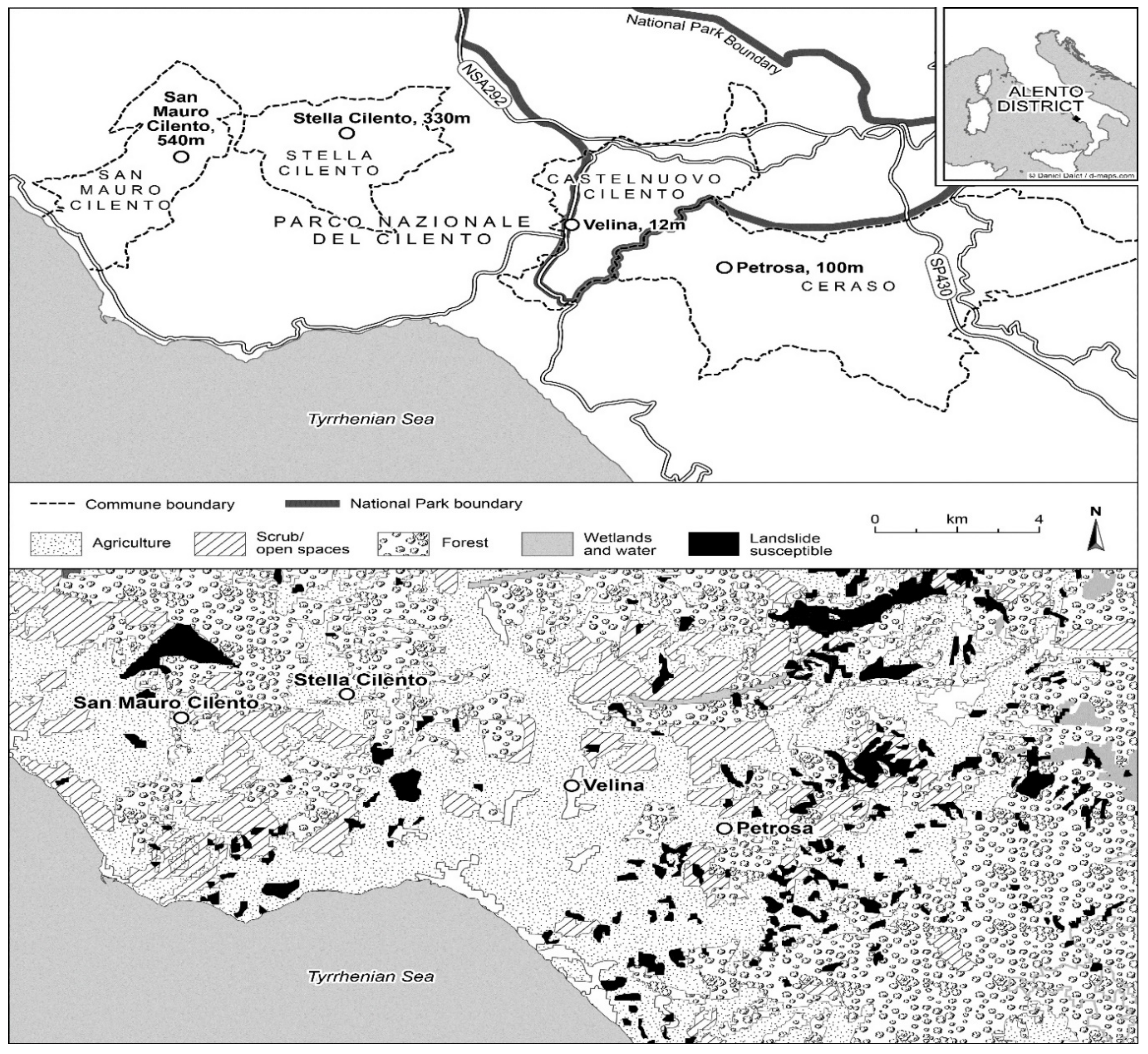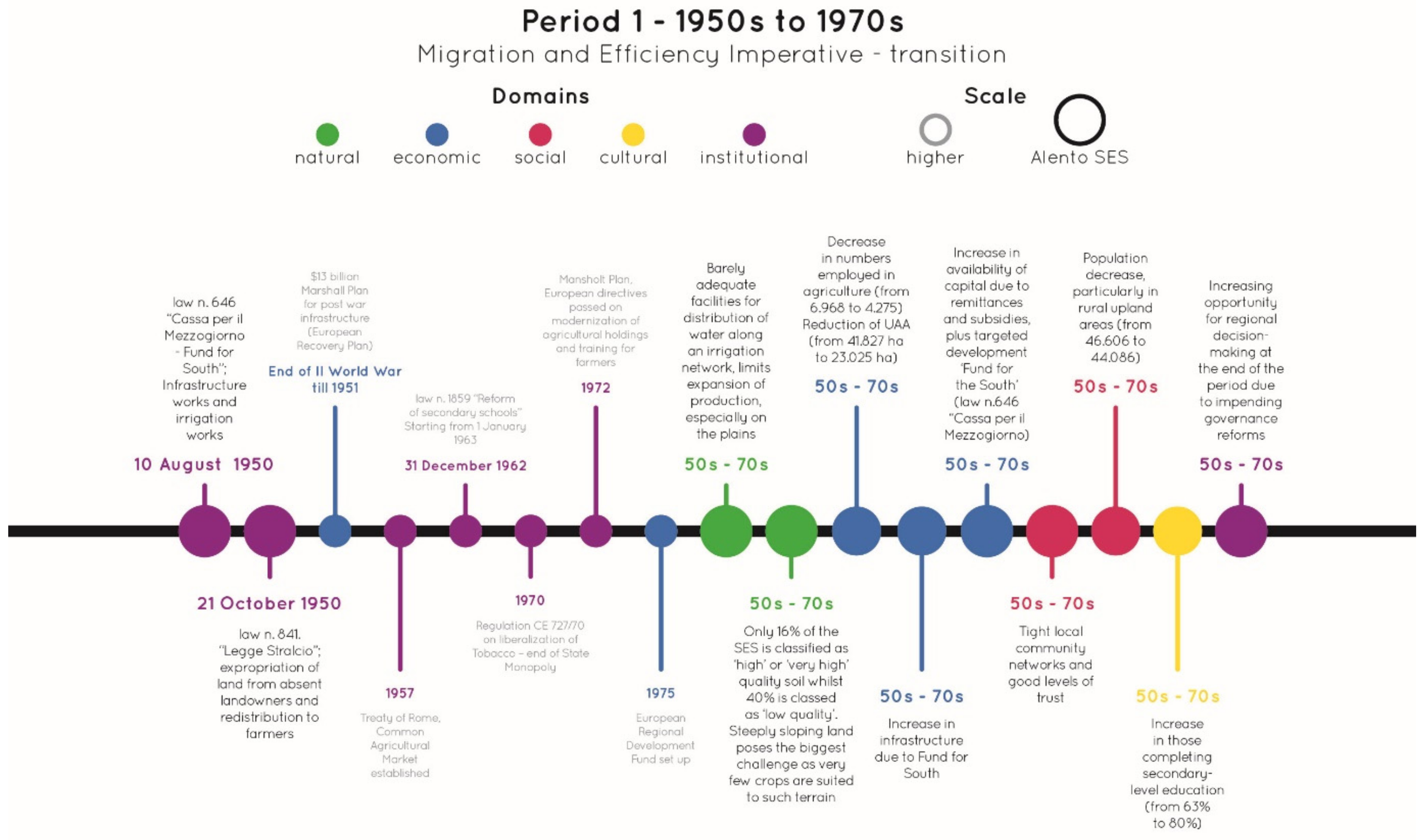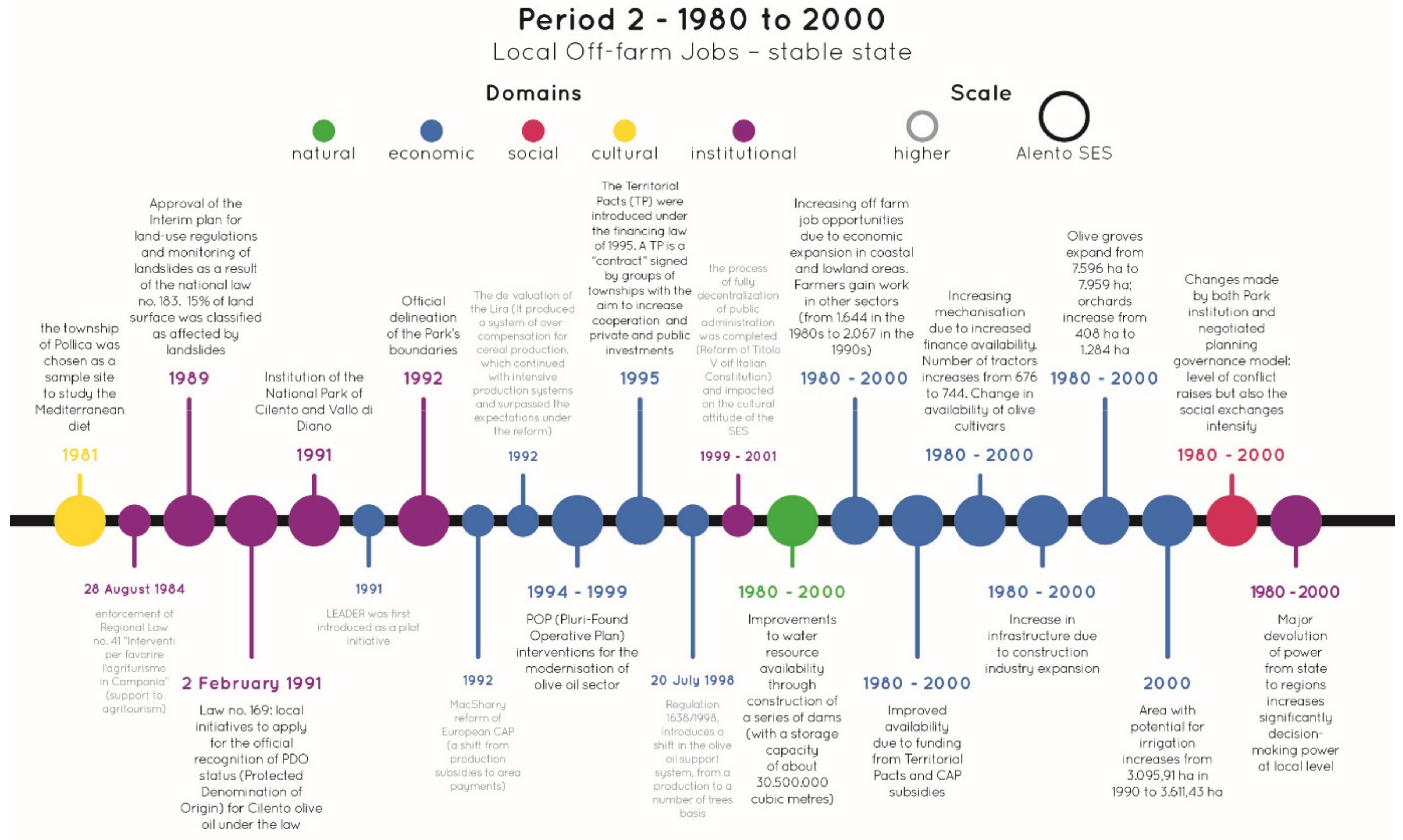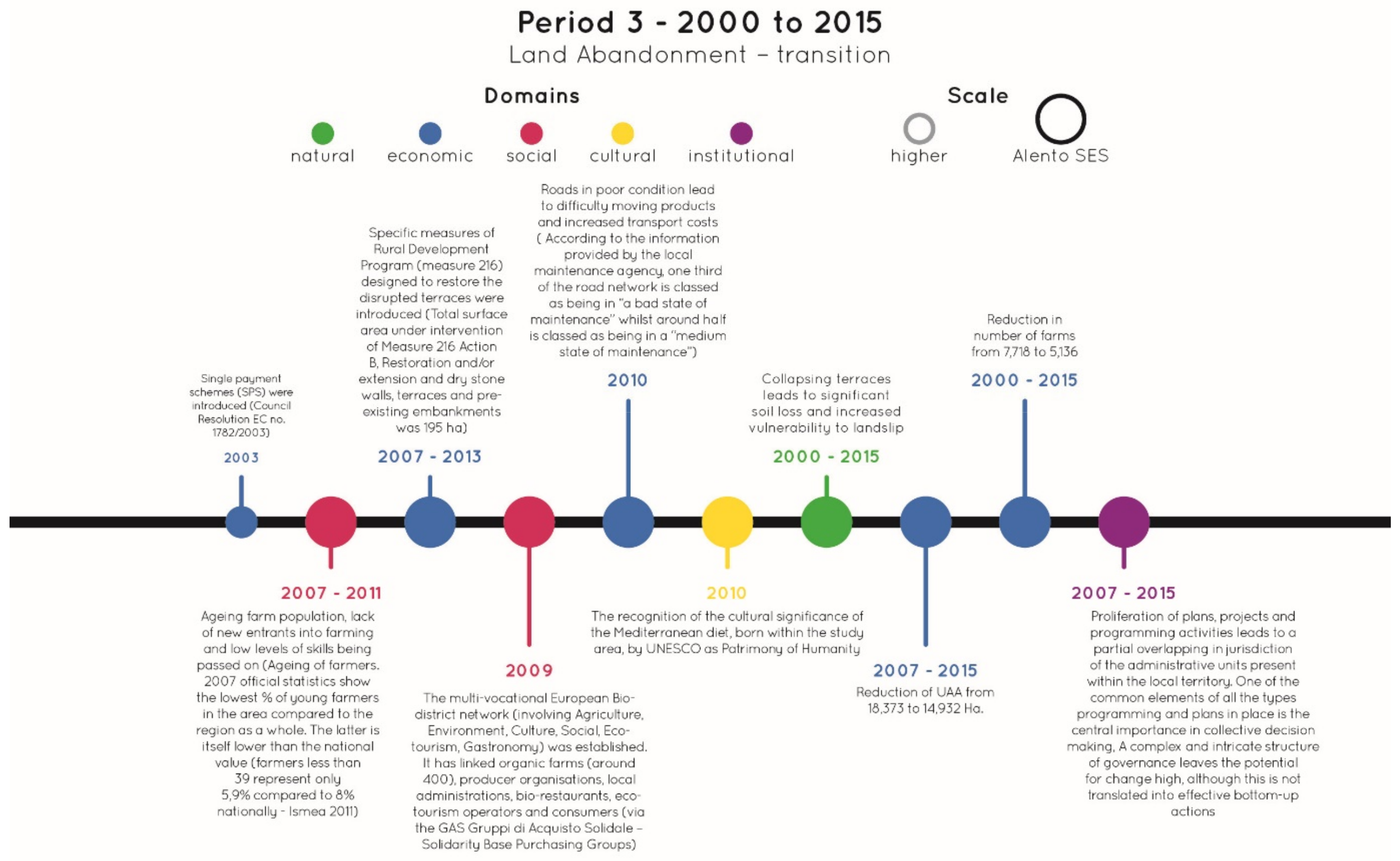A Longitudinal Approach to Examining the Socio-Economic Resilience of the Alento District (Italy) to Land Degradation—1950 to Present
Abstract
:1. Introduction
2. Socio-Ecological and Community Resilience
Land Degradation and Resilience
3. Methods
3.1. The Alento Socio-Ecological System
3.2. Methodological Approach
- Exploration of the evolution of the socio-ecological system over the period of assessment and identification of periods of stability and periods of transition;
- Analysis of the impacts of macro-, meso-, and micro-scalar events and trends on land degradation processes;
- Identification of the specific economic, social, natural, cultural, and political/institutional factors that have driven the observed changes in resilience to land degradation
3.2.1. Quantitative Methods
3.2.2. Qualitative Methods
3.3. A Note on Limitations and Issues
4. Analysis: Three Key Time Periods and the Resilience of the Alento District
4.1. Period 1—1950s to Late 1970s (Migration and Efficiency Imperative—Transition)
“In the past, this community had a strong rural economy thanks to livestock farming and the cultivation of tobacco and grain; it provided lots of jobs for locals and even for the surrounding towns and villages. Things started to decline in the 60s and 70s when there was an economic boom and emigration soared. […] In short, in the past the town was productive and people lived very simply, without the technological advances of today, but they lived well.”
4.2. Period 2—1980 to 2000 (Local Off-Farm Jobs–Stable State)
“Before the 1960s and 1970s farming was considered a vital source of income for the local economy, families didn’t just get by but lived well from farming. Farmers were also pretty self-sufficient and any surplus production was sold on the markets. […]. Today farmers can’t even get by on what they make and need alternative incomes.”Food producer, San Mauro Cilento.
“…many farmers hardly think it’s worth their while to apply for […] funding. The cost of the technicians and the time needed to complete the application discourages small farmers”;
“Farmers with little land often do not apply for the single payment, feeling that there is too much bureaucracy surrounding the process.”Financial Planning Advisor.
4.3. Period 3—2000–2015 (Land Abandonment—Transition)
“emigration has always been a problem in the area, young people nearly all migrate away”, that the “younger generations are trying to leave the area, others have resigned themselves to a future without prospects”, or that “the brightest and best of the younger generations have all left the area.”
5. Discussion
6. Conclusions
Author Contributions
Funding
Acknowledgments
Conflicts of Interest
Appendix A
| Domain | Factors † | Measured Characteristics/Operational Measures |
|---|---|---|
| Natural | Climate | Rainfall, temperature, aridity, evapotranspiration |
| Geology/Geomorphology | Rock types, landforms, slopes | |
| Soils | Soil types, depth, texture, soil organic matter | |
| Water resources | Water bodies, network, water quantity, quality, water balance | |
| Land cover | Land cover types | |
| Economic | Production | GDP by sector; Added Value by sector; Exports by sector; Employment by sector; Number of enterprises (farm and other enterprises); Number of houses built; AUA, Off farm job |
| Financial | Subsidies; Remittances; Bank deposits; Disposable income | |
| Technology | Fertilizers, pesticides, mechanization, etc.; communication technology, IT | |
| Landesque | Terraces, irrigation systems | |
| Physical | Housing, farm structures, factories, roads, dams, communication, energy, irrigation. Schools, hospitals | |
| Animal (Livestock) | Livestock unit (LSU) | |
| Plants and machinery/Land use | Plant used in production; Types, extent, intensity | |
| Social | Social networks | Social, civic, professionals groups |
| Demographics and Population | Size, age-sex, nationality characteristics; net migration | |
| Cultural | Education | Formal and informal education, skills, competences, experience, local environmental knowledge |
| Institutional | Institutions/governance | Administrative organizations, formal and informal institutions, political groups/parties |
| Domain | Factors | |
|---|---|---|
| Natural | Water resources | Barely adequate facilities for distribution of water along an irrigation network limited expansion of production, especially on the plains. |
| Soils | Only 16% of the SES was classified as “high” or “very high” quality soil, while 40% is classed as “low quality”. Steeply sloping land posed the biggest challenge as very few crops are suited to such terrain. | |
| Economic | Production | Decrease in labor employed in agriculture (from 6968 to 4275). Reduction of UAA (from 41,827 to 23,025 ha). Supra-local scale: $13 billion Marshall Plan for post war infrastructure (European Recovery Plan) from end of World War II up until 1951. 1975 European Regional Development Fund set up. |
| Financial | Increase in availability of capital due to remittances and subsidies, plus targeted development Fund for the South (law n.646 “Cassa per il Mezzogiorno). | |
| Physical | Increase in infrastructure due to Fund for South. | |
| Social | Social networks | Tight local community networks and good levels of trust. |
| Population | Decrease, particularly in rural upland areas (from 46,606 to 44,086). | |
| Cultural | Education | Increase in those completing secondary-level education (from 63% to 80%). |
| Institutional | Institutions/governance | Increasing opportunity for regional decision-making at the end of the period due to impending governance reforms. Law 10 August 1950, n. 646 “Cassa per il Mezzogiorno - Fund for South”; Infrastructure works and irrigation works. Law 21 October 1950, n. 841. “Legge Stralcio”; expropriation of land from absent landowners and redistribution to farmers. Supra-local scale: 1957 Treaty of Rome, Common Agricultural Market established. Law 31 December 1962 n. 1859 “Reform of secondary schools” Starting from 1 January 1963. Regulation CE 727/70 on liberalization of Tobacco—end of State monopoly. Mansholt Plan 1972, European directives passed on modernization of agricultural holdings and training for farmers. |
| Domain | Factors | |
|---|---|---|
| Natural | Water resources | Improvements to water resource availability through construction of a series of dams (with a storage capacity of about 30,500,000 cubic meters). |
| Economic | Production | Increasing off farm job opportunities due to economic expansion in coastal and lowland areas. Farmers gained work in other sectors (from 1644 in the 1980s to 2067 in the 1990s). |
| Financial | Improved availability due to funding from Territorial Pacts and CAP subsidies 1994–1999: POP (Pluri-Found Operative Plan) 1994–1999 interventions for the modernization of the olive oil sector. 1995: The Territorial Pacts (TP) were introduced under the financing law of 1995. A TP is a “contract” signed by groups of townships with the aim to increase cooperation and private and public investments. Supra-local scale: 1991: LEADER was first introduced as a pilot initiative. 1992: MacSharry reform of European CAP (a shift from production subsidies to area payments). 1992. The devaluation of the Lira (produced a system of over-compensation for cereal production, which continued with intensive production systems and surpassed the expectations under the reform). 1998: Regulation 1638/1998, of 20 July 1998 introduced a shift in the basis of the olive oil support system, from production to number of trees. | |
| Technology | Increasing mechanization due to increased finance availability. Number of tractors increased from 676 to 744. Change in availability of olive cultivars. | |
| Landesque | Area with potential for irrigation increases from 3095.91 ha in 1990 to 3611.43 ha in 2000. | |
| Physical | Increase in infrastructure due to construction industry expansion. | |
| Plant/Land use | Olive groves expand from 7596 ha to 7959 ha; orchards increase from 408 ha to 1284 ha. | |
| Social | Social networks | Changes made by both National Park institutions and negotiated planning governance model: level of conflict increased but the social exchanges also intensified. |
| Cultural | 1981: The township of Pollica was chosen as a sample site to study the Mediterranean diet. Supra-local scale: Between 1999 and 2001, the process of full decentralization of public administration was completed (Reform of Titolo V of the Italian Constitution) and this impacted on the cultural attitude of the SES. | |
| Institutional | Institutions/governance | Major devolution of power from state to regions significantly increased decision-making power at local level. 1991: Law no.169 of 2/2/1991: local initiatives to apply for official recognition of PDO status (Protected Denomination of Origin) for Cilento olive oil under the law. 1991: Institution of the National Park of Cilento and Vallo di Diano. 1992: Official delineation of the Park’s boundaries. 1989: Approval of the Interim plan for land-use regulations and monitoring of landslides as a result of national law no. 183/1989. 15% of land surface was classified as affected by landslides. Supra-local scale: 1984: enforcement of Regional Law no. 41 of the 28/08/1984 “Interventi per favorire l’agriturismo in Campania” (support to agritourism). |
| Domain | Factors | |
|---|---|---|
| Natural | Soils | Collapsing terraces led to significant soil loss and increased vulnerability to landslips. |
| Economic | Production | Reduction of UAA from 18,373 to 14,932 ha. Reduction in number of farms from 7718 to 5136. Supra-local scale: Single payment schemes (SPS) were introduced in 2003 (Council Resolution EC no. 1782/2003). |
| Landesque | 2007–2013: Introduction of a specific measure under the Rural Development Program (Measure 216) to restore the derelict terraces introduced (total surface area under intervention of Measure 216 Action B, Restoration and/or extension and dry stone walls, terraces, and pre-existing embankments was 195.50 hectares). | |
| Physical | Roads in poor condition led to difficulty moving products and increased transport costs (according to information provided by the local maintenance agency, in 2010, one third of the road network was classed as being in “a bad state of maintenance”, while around half was classed as being in a “medium state of maintenance”). | |
| Social | Population | Ageing farm population, lack of new entrants into farming, and low levels of skills being passed on (2007 official statistics showed the lowest percentage of young farmers in the area compared to the region as a whole. The latter was itself lower than the national average (farmers younger than 39 represented only 5.9% compared to 8% nationally—Ismea 2011)). |
| Social networks | 2009: The multi-vocational European Bio-District Network (involving Agriculture, Environment, Culture, Social, Eco-tourism, Gastronomy) was established. It linked organic farms (around 400), producer organizations, local administrations, bio-restaurants, eco-tourism operators, and consumers (via the GAS Gruppi di Acquisto Solidale—Solidarity Base Purchasing Groups). | |
| Cultural | 2010: The recognition of the cultural significance of the Mediterranean diet, born within the study area, by UNESCO as Patrimony of Humanity. | |
| Institutional | Institutions/governance | Proliferation of plans, projects, and programming activities led to a partial overlapping in jurisdiction of the administrative units present within the local territory. One of the common elements of all these types of programming and plans in place was the central importance in collective decision making, A complex and intricate structure of governance left the potential for change high, although this was not translated into effective bottom-up actions. |
References
- Briassoulis, H. Response assemblages and their socioecological fit: Conceptualizing human responses to environmental degradation. Dialogues Hum. Geogr. 2017, 7, 166–185. [Google Scholar] [CrossRef]
- Wynants, M.; Kelly, C.; Mtei, K.; Munishi, L.; Patrick, A.; Rabinovich, A.; Nasseri, M.; Gilvear, D.; Roberts, N.; Boeckx, P. Drivers of increased soil erosion in East Africa’s agro-pastoral systems: Changing interactions between the social, economic and natural domains. Reg. Environ. Chang. 2019, 19, 1909–1921. [Google Scholar] [CrossRef]
- Borrelli, P.; Robinson, D.A.; Fleischer, L.R.; Lugato, E.; Ballabio, C.; Alewell, C.; Meusburger, K.; Modugno, S.; Schütt, B.; Ferro, V. An assessment of the global impact of 21st century land use change on soil erosion. Nat. Commun. 2017, 8, 2013. [Google Scholar] [CrossRef] [PubMed]
- Knickel, K.; Redman, M.; Darnhofer, I.; Ashkenazy, A.; Calvão Chebach, T.; Šūmane, S.; Tisenkopfs, T.; Zemeckis, R.; Atkociuniene, V.; Rivera, M.; et al. Between aspirations and reality: Making farming, food systems and rural areas more resilient, sustainable and equitable. J. Rural Stud. 2017, 59, 197–210. [Google Scholar] [CrossRef]
- Berkes, F.; Folke, C. (Eds.) Linking Social and Ecological Systems: Management Practices and Social Mechanisms for Building Resilience; Cambridge University Press: Cambridge, UK, 1998. [Google Scholar]
- Gunderson, L.; Holling, C. (Eds.) Panarchy: Understanding Transformations in Human and Natural Systems; Island Press: Washington, DC, USA, 2002; p. 507. [Google Scholar]
- Buikstra, E.; Ross, H.; King, C.A.; Baker, P.G.; Hegney, D.; McLachlan, K.; Rogers-Clark, C. The components of resilience: Perceptions of an Australian rural community. J. Community Psychol. 2010, 38, 975–991. [Google Scholar] [CrossRef]
- Berkes, F.; Ross, H. Community Resilience: Toward an Integrated Approach. Soc. Nat. Resour. 2012, 26, 5–20. [Google Scholar] [CrossRef]
- Wilson, G.A. Community Resilience and Environmental Transitions; Earthscan: London, UK, 2012; p. 251. [Google Scholar]
- Kelly, C.; Ferrara, A.; Wilson, G.A.; Ripullone, F.; Nolè, A.; Harmer, N.; Salvati, L. Community resilience and land degradation in forest and shrubland socio-ecological systems: Evidence from Gorgoglione, Basilicata, Italy. Land Use Policy 2015, 46, 11–20. [Google Scholar] [CrossRef]
- Holling, C. Resilience and stability of ecological systems. Annu. Rev. Ecol. Syst. 1973, 4, 1–23. [Google Scholar] [CrossRef]
- Folke, C.; Carpenter, S.; Elmqvist, T.; Gunderson, L.; Holling, C.; Walker, B.; Bengtsson, J.; Berkes, F.; Colding, J.; Danelle, K.; et al. Resilience and Sustainable Development: Building Adaptive Capacity in a World of Transformations; Scientific Background Paper on Resilience for the process of the World Summit on Sustainable Development; The Environmental Advisory Council to the Swedish Government: Stockholm, Sweden, 2002.
- Pelling, M. The Vulnerability of Cities: Natural Disasters and Social Resilience; Earthscan: London, UK, 2003. [Google Scholar]
- Adger, W.N.; Hughes, T.P.; Folke, C.; Carpenter, S.; Rockstrom, J. Social-ecological resilience to coastal disasters. Science 2005, 309, 1036–1039. [Google Scholar] [CrossRef]
- Anderies, J.M.; Walker, B.H.; Kinzig, A.P. Fifteen weddings and a funeral: Case studies and resilience-based management. Ecol. Soc. 2006, 11, 21. [Google Scholar] [CrossRef]
- Gunderson, L.H.; Carpenter, S.R.; Folke, C.; Olsson, P.; Peterson, G. Water RATs (Resilience, Adaptability, and Transformability) in Lake and Wetland Social-Ecological Systems. Ecol. Soc. 2006, 11, 16. [Google Scholar] [CrossRef]
- Hopkins, R. The Transition Handbook: From Oil Dependency to Local Resilience; Green Book: Dartington, UK, 2008. [Google Scholar]
- Kajoba, G.M. Vulnerability and Resilience of Rural Society in Zambia: From the Viewpoint of Land Tenure and Food Security; Working Paper on Social-Ecological Resilience Series No. 2008-003; Research Institute for Humanity and Nature: Lusaka, Zambia, 2008; p. 41. [Google Scholar]
- Masten, A.S.; Obradovic, J. Disaster preparation and recovery: Lessons from research on resilience in human development. Ecol. Soc. 2008, 13, 9. [Google Scholar] [CrossRef]
- Cinner, J.; Fuentes, M.M.P.B.; Randriamahazo, H. Exploring social resilience in Madagascar’s Marine Protected Areas. Ecol. Soc. 2009, 14, 41–60. [Google Scholar] [CrossRef]
- Resilience Alliance. Urban Resilience. 2009. Available online: www.resalliance.org (accessed on 12 September 2019).
- Darnhofer, I.; Fairweather, J.; Moller, H. Assessing a farm’s sustainability: Insights from resilience thinking. Int. J. Agric. Sustain. 2010, 8, 186–198. [Google Scholar] [CrossRef]
- Fleischman, F.D.; Boenning, K.; Garcia-Lopez, G.A.; Mincey, S.; Schmitt-Harsh, M.; Daedlow, K.; Lopez, M.C.; Basurto, X.; Fischer, B.; Ostrom, E. Disturbance, Response, and Persistence in Self-Organized Forested Communities: Analysis of Robustness and Resilience in Five Communities in Southern Indiana. Ecol. Soc. 2010, 15, 9. [Google Scholar] [CrossRef]
- Berardi, G.; Green, R.; Hammond, B. Stability, sustainability, and catastrophe: Applying resilience thinking to U. S. agriculture. Hum. Ecol. Rev. 2011, 18, 115–125. [Google Scholar]
- Burkhard, B.; Gee, K. Establishing the Resilience of a Coastal-marine Social-ecological System to the Installation of Offshore Wind Farms. Ecol. Soc. 2012, 17, 32. [Google Scholar] [CrossRef]
- Folke, C. Resilience: The emergence of a perspective for social-ecological systems analyses. Glob. Environ. Chang. 2006, 16, 253–267. [Google Scholar] [CrossRef]
- Diamond, J. Collapse: How Societies Choose to Fail or Survive; Penguin: London, UK, 2005. [Google Scholar]
- Stump, D. Ancient and backward or long-lived and sustainable? The role of the past in debates concerning rural livelihoods and resource conservation in eastern Africa. World Dev. 2010, 38, 1251–1262. [Google Scholar] [CrossRef]
- Davidson, J.L.; Jacobson, C.; Lyth, A.; Dedekorkut-Howes, A.; Baldwin, C.L.; Ellison, J.C.; Holbrook, N.J.; Howes, M.J.; Serrao-Neumann, S.; Singh-Peterson, L. Interrogating resilience: Toward a typology to improve its operationalization. Ecol. Soc. 2016, 21, 27. [Google Scholar] [CrossRef]
- Magis, K. Community resilience: An indicator of social sustainability. Soc. Nat. Resour. 2010, 23, 401–416. [Google Scholar] [CrossRef]
- Folke, C.; Carpenter, S.R.; Walker, B.; Scheffer, M.; Chapin, T.; Rockstrom, J. Resilience thinking: Integrating resilience, adaptability and transformability. Ecol. Soc. 2010, 15, 20. [Google Scholar] [CrossRef]
- Cumming, G.S.; Cumming, D.H.M.; Redman, C.L. Scale Mismatches in Social-Ecological Systems: Causes, Consequences and Solutions. Ecol. Soc. 2006, 11, 14. [Google Scholar] [CrossRef]
- Zurlini, G.; Riiters, K.; Zaccarelli, N.; Petrosillo, I.; Jones, K.B.; Rossi, L. Disturbance patterns in a socio-ecological system at multiple scales. Ecol. Complex. 2006, 3, 119–128. [Google Scholar] [CrossRef]
- Reed, M.S.; Buenemann, M.; Atlhopheng, J.; Akhtar-Schuster, M.; Bachmann, F.; Bastin, G.; Bigas, H.; Chanda, R.; Dougill, A.J.; Essahli, W.; et al. Cross-scale monitoring and assessment of land degradation and sustainable land management: A methodological framework for knowledge management. Land Degrad. Dev. 2011, 22, 261–271. [Google Scholar] [CrossRef]
- Wilson, G.A. From productivism to post-productivism and back again? Exploring the (un)changed natural and mental landscapes of European agriculture. Trans. Inst. Br. Geogr. 2001, 26, 77–102. [Google Scholar] [CrossRef]
- Robinson, G. Geographies of Agriculture: Globalisation, Restructuring and Sustainability; Pearson: Harlow, UK, 2004. [Google Scholar]
- Wilson, G.A.; Juntti, M. (Eds.) Unravelling Desertification: Policies and Actor Networks in Southern Europe; Wageningen Academic Publishers: Wageningen, The Netherland, 2005; p. 246. [Google Scholar]
- Wilson, G.A. Multifunctional Agriculture: A Transition Theory Perspective; CAB International: Wallingford, UK, 2007. [Google Scholar]
- Wilson, G.A. Community Resilience and Social Memory. Environ. Values 2015, 24, 227–257. [Google Scholar] [CrossRef]
- Wilson, G.A.; Quaranta, G.; Kelly, C.; Salvia, R. Community resilience, land degradation and endogenous lock-in effects: Evidence from the Alento region, Campania, Italy. J. Environ. Plan. Manag. 2016, 59, 518–537. [Google Scholar] [CrossRef]
- Wilson, G.A.; Kelly, C.L.; Briassoulis, H.; Ferrara, A.; Quaranta, G.; Salvia, R.; Detsis, V.; Curfs, M.; Cerda, A.; El-Aich, A.; et al. Social memory and the resilience of communities affected by land degradation. Land Degrad. Dev. 2016, 28, 383–400. [Google Scholar] [CrossRef]
- Sutherland, L.-A.; Darnhofer, I.; Wilson, G.; Zagata, L. (Eds.) Transition Pathways Towards Sustainability in Agriculture: Case Studies from Europe; CABI: Wallingford, UK, 2014. [Google Scholar]
- Quaranta, G.; Salvia, R. Sustainability patterns and policy fit: Evidences from a mixed approach applied in a euromediterranean area. Riv. di Studi Sulla Sostenibilità 2014, 2, 59–81. [Google Scholar] [CrossRef]
- Becker, H. Cases, causes, conjunctures, stories and imagery. In Case Study Method: Key Issues, Key Texts; Gomm, R., Hammersley, M., Foster, P., Eds.; Sage: London, UK, 2000; pp. 223–233. [Google Scholar]
- Polkinghorne, D. Narrative configuration in qualitative analysis. In Life History and Narrative; Hatch, J.A., Wisniewski, R., Eds.; The Falmer Press: London, UK, 1995; pp. 5–23. [Google Scholar]
- Resilience Alliance. Assessing and Managing Resilience in Social-Ecological Systems: A Practitioners Workbook The Resilience Alliance. Volume 1 Version 1.084. 2007. Available online: http://www.resalliance.org/3871.php (accessed on 17 September 2019).
- Briassoulis, H. The Socio-ecological Fit of Human Responses to Environmental Degradation: An Integrated Assessment Methodology. Environ. Manag. 2015, 56, 1448–1466. [Google Scholar] [CrossRef] [PubMed]
- Ferrara, A.; Kelly, C.; Wilson, G.A.; Nolè, A.; Mancino, G.; Bajocco, S.; Salvati, L. Shaping the role of “fast” and “slow” drivers of change in forest-shrubland socio-ecological systems. J. Environ. Manag. 2016, 169, 155–166. [Google Scholar] [CrossRef] [PubMed] [Green Version]
- Rossi Doria, M. La Calabria Agricola e il Suo Avvenire. IL Ponte 1950, 8, 9. [Google Scholar]
- Beguinot, C.; Galasso, G.; Petriccione, S.; Turco, C. Problemi demografici e questione meridionale. ESI 1959, 8, 285. [Google Scholar]
- Levi, C. Christ Stopped at Eboli. The story of a Year; Farrar Strauss and Company: New York, NY, USA, 1947. [Google Scholar]
- Cafiero, S.; Marciani, G.E. Quarant’anni di intervento straordinario nel Mezzogiorno (1950–1989). Riv. Econ. del Mezzog. 1991, 2, 249–274. [Google Scholar]
- INEA. L’economia Agraria Della Campania; Edizioni Italiane: Roma, Italy, 1948. [Google Scholar]
- INEA. La Distribuzione Della Proprietà Fondiaria in Italia: Tavole Statistiche: Campania; Edizioni Italiane: Roma, Italy, 1947. [Google Scholar]
- Pascale, A. Radici & Gemme. La Società Civile Delle Campagne DALL’UNITÀ ad Oggi; Cavinato Editore International: Brescia, Italy, 2013. [Google Scholar]
- Di Nola, A.M. Mutazione culturale negli ultimi cinquant’anni. In Storia del Mezzogiorno; Editalia: Roma, Italy, 1994; p. 395. [Google Scholar]
- Trigilia, C. Sviluppo Senza Autonomia. Effetti Perversi Delle Politiche nel Mezzogiorno; Il Mulino: Bologna, Italy, 1992. [Google Scholar]
- Barca, F. L’Italia Frenata—Paradossi e Lezioni della Politica per lo Sviluppo; Donzelli Editore: Roma, Italy, 2006; p. 128. [Google Scholar]
- Wilson, G.A. Community resilience: Path dependency, lock-in effects and transitional ruptures. J. Environ. Plan. Manag. 2013, 57, 1–26. [Google Scholar] [CrossRef]
- Mistry, J.; Berardi, A.; Haynes, L.; Davis, D.; Xavier, R.; Andries, J. The role of social memory in natural resource management: Insights from participatory video. Trans. Inst. Br. Geogr. 2014, 39, 115–127. [Google Scholar] [CrossRef] [Green Version]
- Briassoulis, H. Governing desertification in Mediterranean Europe: The challenge of environmental policy integration in multi-level governance contexts. Land Degrad. Dev. 2010, 22, 313–325. [Google Scholar] [CrossRef]
- Berkes, F.; Colding, J.; Folke, C. Rediscovery of Traditional Ecological Knowledge as Adaptive Management. Ecol. Appl. 2000, 10, 1251–1262. [Google Scholar] [CrossRef]
- Reed, M.S.; Dougill, A.J.; Taylor, M.J. Integrating local and scientific knowledge for adaptation to land degradation: Kalahari rangeland management options. Land Degrad. Dev. 2007, 18, 249–268. [Google Scholar] [CrossRef]
- Von Glasenapp, M.; Thornton, T.F. Traditional ecological knowledge of Swiss alpine farmers and their resilience to socioecological change. Hum. Ecol. 2011, 39, 769–781. [Google Scholar] [CrossRef]
- Ahlborg, H.; Nightingale, A.J. Mismatch Between Scales of Knowledge in Nepalese Forestry: Epistemology, Power, and Policy Implications. Ecol. Soc. 2012, 17, 16. [Google Scholar] [CrossRef] [Green Version]
- Anderies, J.M.; Janssen, M.A.; Ostrom, E. A Framework to Analyze the Robustness of Social-ecological Systems from an Institutional Perspective. Ecol. Soc. 2004, 9, 18. [Google Scholar] [CrossRef]
- Abel, N.; Cumming, D.H.M.; Anderies, J.M. Collapse and reorganization in social-ecological systems: Questions, some ideas and policy implications. Ecol. Soc. 2006, 11, 17. [Google Scholar] [CrossRef] [Green Version]
- Resilience Alliance. Assessing resilience in social-ecological systems: A workbook for scientists. The Resilience Alliance. 2007. Available online: www.resalliance.org/3871.php (accessed on 17 September 2019).
- Ostrom, E. A general framework for analyzing sustainability of social-ecological systems. Science 2009, 325, 419–422. [Google Scholar] [CrossRef]
- Davidson, J.L.; van Putten, I.E.; Leith, P.; Nursey-Bray, M.; Madin, E.M.; Holbrook, N.J. Toward Operationalizing Resilience Concepts in Australian Marine Sectors Coping with Climate Change. Ecol. Soc. 2013, 18, 4. [Google Scholar] [CrossRef] [Green Version]
- LEDDRA Partners. Assessing the Fit of Responses to LEDD: Theory, Assessment, Applications, Proposals, Knowledge Transfer: Methodology and First Synthesis; University of the Aegean: Mytilene, Lésvos, 2012; p. 76. [Google Scholar]




© 2019 by the authors. Licensee MDPI, Basel, Switzerland. This article is an open access article distributed under the terms and conditions of the Creative Commons Attribution (CC BY) license (http://creativecommons.org/licenses/by/4.0/).
Share and Cite
Salvia, R.; Kelly, C.L.; Wilson, G.A.; Quaranta, G. A Longitudinal Approach to Examining the Socio-Economic Resilience of the Alento District (Italy) to Land Degradation—1950 to Present. Sustainability 2019, 11, 6762. https://doi.org/10.3390/su11236762
Salvia R, Kelly CL, Wilson GA, Quaranta G. A Longitudinal Approach to Examining the Socio-Economic Resilience of the Alento District (Italy) to Land Degradation—1950 to Present. Sustainability. 2019; 11(23):6762. https://doi.org/10.3390/su11236762
Chicago/Turabian StyleSalvia, Rosanna, Claire L. Kelly, Geoff A. Wilson, and Giovanni Quaranta. 2019. "A Longitudinal Approach to Examining the Socio-Economic Resilience of the Alento District (Italy) to Land Degradation—1950 to Present" Sustainability 11, no. 23: 6762. https://doi.org/10.3390/su11236762
APA StyleSalvia, R., Kelly, C. L., Wilson, G. A., & Quaranta, G. (2019). A Longitudinal Approach to Examining the Socio-Economic Resilience of the Alento District (Italy) to Land Degradation—1950 to Present. Sustainability, 11(23), 6762. https://doi.org/10.3390/su11236762







